Carthaginian Warfare › Carthago Nova › Ancient Egyptian Agriculture » Origins and History
Articles and Definitions › Contents
- Carthaginian Warfare › Origins
- Carthago Nova › Origins
- Ancient Egyptian Agriculture › Origins
Ancient civilizations › Historical places, and their characters
Carthaginian Warfare › Origins
Definition and Origins
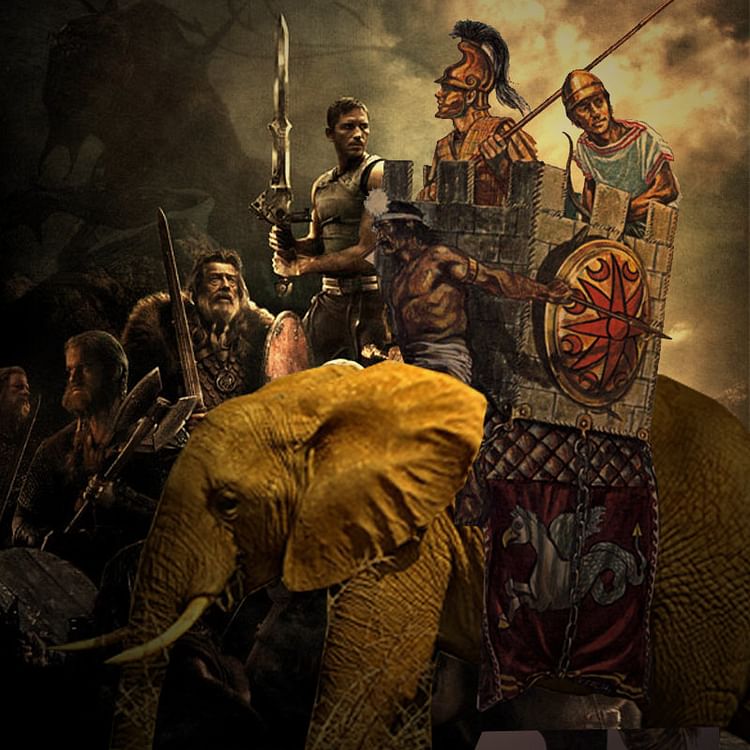
Carthaginian warfare has been overshadowed by defeat to Rome in the Punic Wars, but for six centuries before that Carthage was remarkably successful in conquering lucrative territories in North Africa, the Iberian Peninsula, and Sicily. By combining the finest mercenary armies with their own elite forces and huge naval fleet, Carthage was able to dominate the western Mediterranean and protect and expand its vast network of colonies and trading posts from the 9th to 3rd centuries BCE.
PURPOSE OF WAR
Carthage was founded by the Phoenician city of Tyre in 813 BCE as a handy location along western Mediterranean trade routes, and the colony would go on to prosper and found its own colonies, eventually taking over the old Phoenician network too. Such a large geographical spread of interests required a naval fleet to safeguard both the ships which plied their trade across the seas and the ports which gave them protection and access to lucrative hinterlands. In addition, a land army was sometimes required in order to defend Carthage's trading interests from local tribes and rival powers, especially the tyrants of Sicily and later Rome. Another, equally important role for armies was as an offensive means to expand the empire by taking control of new territories rich in natural resources such as the silver mines of Iberia.
CEREMONIES OF WAR
As with most other ancient cultures warfare for the Carthaginians was, like any other state activity, inseparable from religious beliefs. War could not be conducted without divine sanction. Accordingly, sacrifices were made to the Punic gods before key battles in order to ensure their favour and ultimate victory. Sometimes during a long conflict even new temples were built to such important deities as Tanit, Melqart, and Baal Hammon to please them and make sure their support did not waver. Animal entrails were read too prior to battles, where omens were established which reassured the troops with their promise of victory.In dire moments sacrifices were also made in a last ditch effort to avoid defeat. The most notorious example of this, recounted by the ancient historian Diodorus, was when Agathocles, the tyrant of Syracuse, invaded North Africa in 310 BCE. In response to this threat hundreds of noble children were sacrificed. So too, after the battle, victories were celebrated with more sacrifices and conquests were recorded on tablets and stelae set up at Punic temples.
CARTHAGE WAS AN ACCOMPLISHED PRACTITIONER OF WARFARE FOR CENTURIES ACQUIRING NEW TERRITORIES & RESOURCES, & SAFEGUARDING ITS VAST TRADE NETWORK.
COMMANDERS
The commander of a Carthaginian army or naval force ( rab mahanet ) was selected for the duration of a specific war, usually from the ruling family. The general may often have had complete autonomy of action or, on other occasions, had to rely on the Carthaginian government for such important decisions as when to hold a truce, sue for peace, or withdraw. In addition, after a battle or war, the commanders were subjected to a tribunal which investigated their competence or otherwise. There was intense competition between commanders, not helped by the fact that command was sometimes shared between two, or even three, generals.
Motivation for commanders was high too as those generals who failed in wartime were treated harshly. One of the lesser punishments was a large fine whilst the worst case scenario was crucifixion. Several commanders, following defeat, committed suicide to avoid the latter penalty. A serious consequence of the fear of failure inherent in the army command structure may have been that generals tended to be overcautious and conservative in battle. This was in direct contrast to Romancommanders who had their command for one year, only leading to a more aggressive approach to warfare as they tried to win total victory before being removed from office.

Hannibal Barca
The more successful commanders not only possessed the military skills to exploit the unique situations of individual battles and the weaknesses of their enemies but also the ability to mould their own mercenary fighting force into a homogenous unit.This was primarily achieved by a cult of personality. Hannibal, for example, went one step further than his father Hamilcar Barca (who had used such imagery on his coins) and identified himself as Hercules -Melqart, the figure who was a mix of the invincible Greek hero and the Phoenician-Punic god. This appealed to both Carthaginians and Greeks. It was a handy propaganda tool with Greek contingents in the Carthaginian army and when fighting in such places as Magna Graecia where the cult was as strong as anywhere. To bolster his divine claims Hannibal once recounted a dream he had had where Melqart specifically instructed him to invade Italy and even gave him a guide to get there in the most efficient way. All of these ploys helped to reassure the common soldier that they were fighting on the right side with the best general.
SOLDIERS & WEAPONS
The army of Carthage the city was composed of heavily armoured infantry drawn from the citizenry. This was an elite group of 2,500-3,000 infantry soldiers identified by their white shields and known as the Sacred Band. The bulk of the Carthaginian army which fought across the empire was, though, composed largely of mercenary units – both paid local allies (eg from Libya and Tunisia) and mercenary armies from Greece, Iberia, Southern Italy, and Gaul. One of the best corps in the Carthaginian army was the cavalry force of their allies, the Numidians. To avoid the threat that successful mercenary armies rebelled against the ruling elite of Carthage, the Carthaginians made sure that all senior and middle command positions were held by citizens of Carthage. Nevertheless, despite this precaution, in several instances mercenary armies would prove to be disloyal and even cause in-fighting between the rival clans of Carthage's aristocracy, most famously during the Truceless War (aka Mercenary War, 241-237 BCE).
As the armies of Carthage were usually composite groups of foreign mercenary forces; their weapons and armour differed depending on the unit's origin or preferences. In addition, the Carthaginians were not averse to equipping themselves with the arms and armour of their fallen enemies. The Greek hoplite was perhaps the most common model – heavy armour, large shield, spear, and sword. There were also contingents of slingers and archers. Up to the 3rd century BCE war chariots were used, but their limitation of requiring good terrain saw their eventual abandonment in favour of more mobile cavalry.
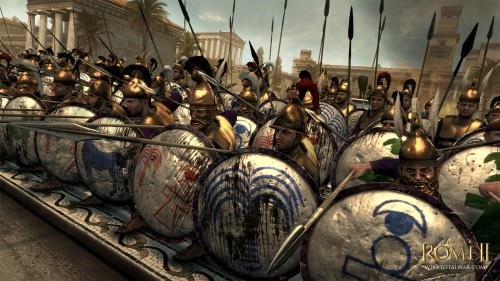
Carthaginian Mercenaries
Artillery was a component of Carthaginian armies in Sicily where the cities were well-fortified. The Carthaginians were quick to copy the Hellenistic inventions of catapult (for stones and incendiaries) and crossbows. During a siege, they also employed battering rams, mobile siege towers, mounds, and mining to overcome enemy fortifications. We know that Carthage itself was equipped with artillery machines for defence.
One of the most distinctive Carthaginian weapons was the war elephant. Tusked and reaching a height of 2.5 metres, the elephants were made even more fearsome by adding armour to the head, trunk, and sides, and blades or spears to the tusks.Controlled by their driver ( mahout ), they were used in front of the infantry lines to disrupt enemy formations and to harass the enemy from the wings or rear. Not large enough to carry a superstructure ( howdah ), the type of elephant used by Carthage may have permitted a second rider armed with a bow or javelins. No doubt the appearance and noise of elephants caused panic amongst the enemy's men and horses, but they were wildly unpredictable in battle and could cause as much damage to their own side as the opposition. When enemy forces became used to them and trained their horses not to panic or if the terrain was unsuitable, then their effectiveness was greatly reduced.
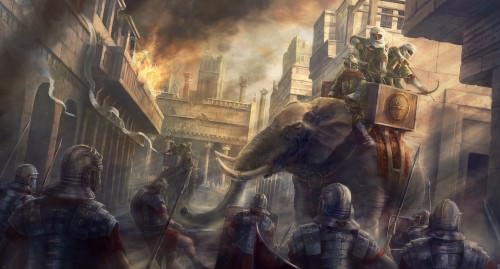
Carthaginian War Elephant
STRATEGIES
In land battles, after an initial round of skirmishes involving light cavalry, the Carthaginian army attacked the enemy head-on with heavy infantry, much like the Greeks had been doing for centuries with the phalanx (a line of tightly grouped hoplites protecting each other with their shields). Hannibal, however, showed a willingness to adapt superior enemy tactics and formations such as after the Battle of Lake Trasimene (217 BCE) when he likely adapted the more flexible Roman maniple troop deployment as opposed to the more static phalanx.
Light infantry was stationed on the wings and protected the flanks of the phalanx which might draw in the enemy lines. Troops were coordinated during battle using standards. Each ethnic group would have had their own, such as the Celtic wild boar image, and shield blazons were also used to identify who was who. When not involved in head-to-head battles to break up formations and harass the enemy's flanks, the cavalry units were used to ambush enemy troops, lead them into ambush by infantry troops, or in guerrilla tactics to constantly harass enemy armies and their logistical support.
NAVAL WARFARE
The size of the Carthaginian fleet changed depending on the period, but according to the ancient historian Polybius, Carthage had a fleet of 350 ships in 256 BCE. Such were the requirements of Carthage's large navy that ships were constructed using mass-produced pieces marked with numbers for ease of assembly.
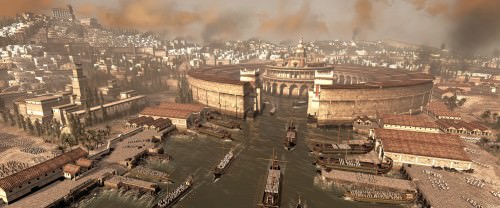
Carthage and its Harbour
The naval fleet of Carthage was composed of large warships propelled by sail and oars which were used to ram enemy vessels using a bronze ram mounted on the prow below the waterline. The ships were the trireme with three banks of rowers, the quadrireme, and quinquereme. The quinquereme, so called for its arrangement of five rowers per vertical line of three oars (a total of 300 rowers), became the most widely used in the Punic fleet. Catapults could be mounted on the deck of these large vessels but were probably limited to siege warfare and not used in ship-to-ship battles.
Attempts to ram enemy ships could be made in two ways. The first, the diekplous or breakthrough, was when ships formed a single line and sailed right through the enemy lines at a selected weak point. The defending ships would try not to create any gaps in their formation and perhaps stagger their lines to counter the diekplous. The second tactic, known as periplous, was to try and sail down the flanks of the enemy formation and attack from the sides and rear. This strategy could be countered by spreading one's ships as wide as possible but not too much so as to allow a diekplous attack. Positioning a fleet with one flank protected by a shoreline could also help counter a periplous manoeuvre, especially from a more numerous enemy. While all this chaotic ramming was going on, smaller vessels were used to haul stricken ships away from the battle lines or even to tow away captured vessels. Oarsmen were expected to fight in landing operations and help build siege engines but not in ship-to-ship battles. The larger ships were decked and would have carried complements of armed men, both archers and marines armed with spears, javelins, and swords, who could board enemy vessels given the opportunity.
Aside from naval battles, the Carthaginian fleet was also vital for transporting armies, resupplying them by providing an escort for transport ships, coastal raids, attacking enemy supply ships, blockading enemy ports, and relieving Carthaginian forces when they were themselves besieged.
VICTOR'S SPOILS & REPRISALS
The rewards of military victory for Carthage were control of new territories with their natural resources, acquisition of slaves, sometimes the incorporation of parts of the defeated army into their own, and the state treasuries and granaries of conquered cities. As Carthage employed mercenaries, one of the first priorities after a victory was to pay them, and this was done with coinage or by allowing the soldiers to take any booty they could get their hands on from the defeated – weapons, armour, jewellery, foodstuffs, and so on.
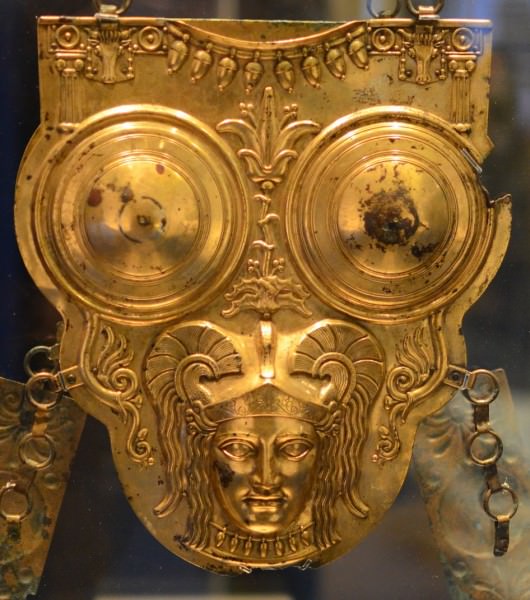
Punic Cuirass
Carthage earned a bloody reputation for its treatment of the vanquished, but this should be tempered with the fact that most of the sources are pro-Roman. We know, for example, that Hannibal released non-Roman enemy troops on several occasions to increase the chances of local areas revolting against Rome. Similarly, some were promised the return of their land which had been taken from them by the Romans. Certainly, though, sometimes war prisoners were sacrificed to honour the Punic gods and give thanks for victory. There are also tales of prisoners being executed en masse, sometimes imaginatively as in one case where elephants were used to trample the unarmed captives. Defeated leaders could expect no better and were often cruelly executed. One Hasdrubal is known to have crucified the Iberian prince Tagua, a Celtic leader named Indortes was blinded before he was crucified, and the Roman general Regulus was put inside a barrel lined with spikes and then rolled through the streets of Carthage.
This brutality did sometimes serve a political purpose for canny generals could then seem especially generous when they treated the defeated well, they could encourage enemy cities to capitulate without much bloodshed and avoid the same fate and, perhaps not least, persuade their own troops of what they could expect in retaliation themselves from the enemy if they were captured, and so they became even more motivated to fight well.
FAMOUS VICTORIES
In some theatres the Carthaginian army enjoyed great successes, notably in North Africa, Sicily, and Spain. An important victory came near Tunis during the First Punic War (264 - 241 BCE) with Rome when the Carthaginians wisely employed the mercenary Spartan commander Xanthippus. In 255 BCE, he reorganised the army and brilliantly combined 100 war-elephants with 12,000 infantry and 4,000 cavalry to totally defeat two legions and capture the Roman general Regulus in the process.12,000 Romans were killed against 800 Carthaginians.
The great general Hamilcar Barca was particularly successful in Spain in the 230s BCE. He supplemented his original landing force of some 25,000 with local recruits and amassed a 50,000-strong army which included 100 elephants. Using a blend of terror and diplomacy, Hamilcar relentlessly expanded his control over southern Spain, and the riches from these campaigns were channelled back to Carthage to make it the wealthiest city in the ancient world.

Hamilcar Barca
Perhaps the finest hour of Carthage's army was Hannibal's streak of four great battles against Rome in Italy during the Second Punic War (218 - 201 BCE). His victories at the Ticinus (Ticino) River near Pavia and the Trebia River in December 218 BCE, Lake Trasimene in June 217 BCE, and at Cannae in Apulia in August 216 BCE rocked the Roman world. Masterfully blending his mixed mercenary army into a coherent and disciplined whole, taking full advantage of local terrain, and employing his troops in fast battlefield manoeuvres, Hannibal, for a while at least, was invincible.
INFAMOUS LOSSES
Perhaps Carthage's most shocking naval loss was their very first sea engagement with Rome at the battle of Mylae (Milazzo) in 260 BCE. The Roman fleet of 145 ships defeated the Carthaginian fleet of 130 ships which had not even bothered to form battle lines, so confident were they of victory against the untested Roman sailors. When the Carthaginian flagship was captured, the commander was forced to ignominiously flee in a rowing boat.
In 202 BCE, the Roman general Scipio Africanus famously defeated the great Hannibal and his elephants at the Battle of Zama in western Tunisia. Scipio managed to persuade the Numidian cavalry to join his cause and he brilliantly arranged his infantry to form corridors which allowed Hannibal's 80 elephants to harmlessly charge through, then sent them back to cause havoc with the Carthaginian lines. It was the battle which would end the Second Punic War and, effectively, Carthage's position as a major power.
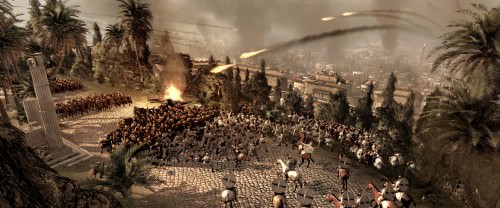
Carthage Under Siege
Carthage's greatest loss was nothing less than total destruction at the hands of the Romans in the Third Punic War (149-146 BCE). After a lengthy siege and staunch resistance, the city finally fell to the siege engines of Scipio Africanus the Younger.Buildings were destroyed, the people were sold into slavery, and the land officially cursed.
CONCLUSION
Carthage was, then, an accomplished practitioner of warfare for centuries but eventually, and despite a heroic effort which several times almost brought victory, more than met its match in Rome with its professional and well-trained army backed by a seemingly endless pool of replacements and financial support. The inherent weaknesses in the Carthaginian army - disparate groups of sometimes disloyal mercenaries, confused command structures, and an over-reliance on heavy infantry and war elephants - meant that Carthage was, ultimately, unable to maintain its position as a Mediterranean superpower and keep pace with mighty Rome.
Carthago Nova › Origins
Definition and Origins

Along the southern coast of the Iberian Peninsula lies the ancient city of Carthago Nova (New Carthage, modern day Cartagena in Spain). Originally named Martia, the area was captured in 228 BCE by Hasdrubal Barca (brother of Hannibaland second son of Hamilicar Barca) during the Carthaginian conquest of Spain. However, it would remain under their rule for only seventeen years. In the later stages of the Second Punic War between Carthage and Rome (210-209 BCE), the Romangeneral Scipio Africanus captured the city complete with its plentiful stores and supplies, making it an imperial stronghold.The abundant natural resources: silver, lead, and iron ore, as well as its excellent harbour made it a strategic as well as a major economic acquisition.
The Roman conquest of the city brought about an unexpected advantage - Scipios's humanitarian efforts towards both prisoners as well as hostages portrayed Rome as liberators not conquerors. He would later defeat Hannibal at the Battle of Zama, ending the war and all but destroying Carthage's empire along the Mediterranean Sea.
Recent excavations of the area have shown the city to have been a very prosperous and typically Roman city with an amphitheatre, patriotic homes and even Roman walls. After a visit to the city in 133 BCE historian Polybius wrote about it in The Histories, considering it to be a true capital - spectacular temples, luxurious palaces, massive walls and a busy harbour.

Roman Theatre of Carthago Nova
The city was made a colonia by Julius Caesar in 42 BCE, and later renamed Colonia Victrix Iulia Nova Carthago by Emperor Augustus. It also played an important part in the downfall of Emperor Nero. In the Year of the Four Emperors (69 CE) Governor-general Galba of Spain was in Carthago Nova at a council of justice when he heard of the uprising in Gaul. Shortly afterwards, he was asked to “aid in rescuing humanity from Nero.” He left Spain with an army, intent on overthrowing Nero;however, Nero committed suicide before he arrived. Galba was named the new emperor, only to be assassinated a few months later at the urging of the future emperor Otho.
Later, Carthago Nova was renamed Carthaginesis and made the provincial capital of Hispania under Emperor Diocletian and, in 550 CE, despite having been conquered by the Visigoths (425 – 551 CE), Byzantine emperor Justinian made it the capital of Spania. After the Byzantines, the city came under Muslim control.
Ancient Egyptian Agriculture › Origins
Ancient Civilizations
Agriculture was the foundation of the ancient Egyptian economy and vital to the lives of the people of the land. Agricultural practices began in the Delta Region of northern Egypt and the fertile basin known as the Faiyum in the Predynastic Period in Egypt (c. 6000 - c. 3150 BCE), but there is evidence of agricultural use and overuse of the land dating back to 8000 BCE.

Threshing of Grain in Egypt
Egyptologist and historian Margaret Bunson defines ancient Egyptian agriculture as "the science and practice of the ancient Egyptians from predynastic times that enabled them to transform an expanse of semiarid land into rich fields after each inundation of the Nile " (4). In this, she is referring to the yearly flooding of the Nile River which rose over its banks to deposit nutrient-rich soil on the land, allowing for the cultivation of crops. Without the inundation, Egyptian culture could not have taken hold in the Nile River Valley and their civilization would never have been established. So important was the Nile flood that scholars believe many, if not most, of the best known Egyptian myths are linked to, or directly inspired by, this event. The story of the death and resurrection of the god Osiris, for example, is thought to have initially been an allegory for the life-giving inundation of the Nile, and numerous gods throughout Egypt's history are directly or indirectly linked to the river's flood.
So fertile were the fields of Egypt that, in a good season, they produced enough food to feed every person in the country abundantly for a year and still have surplus, which was stored in state-owned granaries and used in trade or saved for leaner times. A bad growing season was always the result of a shallow inundation by the Nile, no matter the amount of rainfall or what other factors came into play.
TOOLS & PRACTICES
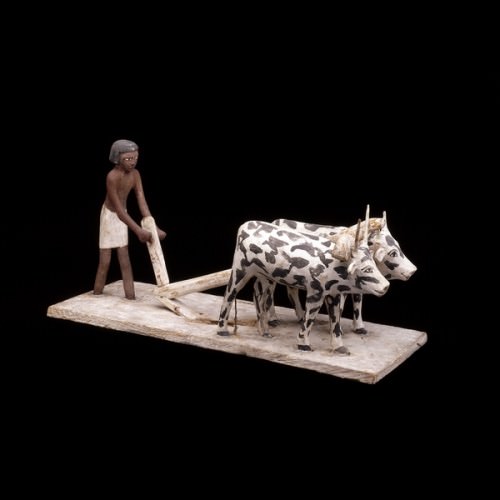
Wooden model of a man ploughing with oxen
Once the ground was broken and the clods dispersed, seed was carried to the field in baskets and workers filled smaller baskets or sacks from these larger containers. The most common means of sowing the earth was to carry a basket in one arm while flinging the seed with the other hand.

Egyptian Hoe
Some farmers were able to afford the luxury of a large basket one attached to the chest by hemp straps which enabled one to use two hands in sowing. To press the seed into the furrows, livestock was driven across the field and the furrows were then closed by workers with hoes. All of this work would have been for nothing, however, if the seeds were denied sufficient water and so regular irrigation of the land was extremely important.
CANALS
THE YEARLY INUNDATION OF THE NILE WAS ESSENTIAL TO EGYPTIAN LIFE, BUT IRRIGATION CANALS WERE NECESSARY TO CARRY WATER TO OUTLYING FARMS & VILLAGES AS WELL AS TO MAINTAIN EVEN SATURATION OF CROPS NEAR THE RIVER.
Egyptian irrigation techniques were so effective they were implemented by the cultures of Greece and Rome. Irrigation was not an Egyptian invention, however, but was introduced during the Second Intermediate Period of Egypt (c. 1782 - c.1570 BCE) by the people known as the Hyksos, who settled in Avaris in Lower Egypt; the Egyptians simply improved upon the techniques. The yearly inundation of the Nile was essential to Egyptian life, but irrigation canals were necessary to carry water to outlying farms and villages as well as to maintain even saturation of crops near the river. Egyptologist Barbara Watterson notes how the Delta Region of Lower Egypt was far more fertile than the fields of Upper Egypt toward the south and so "the Upper Egyptian farmer had to be inventive and, at an early date, learned to cooperate with his neighbours in harnessing the river water through the building of irrigation canals and drainage ditches" (40).
These canals were carefully engineered to efficiently water the fields but, most importantly, not to interfere with anyone else's crops or canals. This aspect of canal construction was so important that it was included in the Negative Confession, the proclamation a soul would make after death when it stood in judgment. Among the Confessions are numbers 33 and 34 in which the soul claims it has never obstructed water in another's canal and has never cut into someone else's canal illegally.After receiving permission to dig a canal, estate owners and farmers were responsible for the proper construction and maintenance of it. Bunson writes:
Early farmers dug trenches from the Nile shore to the farmlands, using draw wells and then the Shaduf, a primitive machine that allowed them to raise levels of water from the Nile into canals...Fields thus irrigated produced abundant annual crops. From the predynastic times agriculture was the mainstay of the Egyptian economy. Most Egyptians were employed in agricultural labors, either on their own lands or on the estates of the temples or nobles. Control of irrigation became a major concern and provincial officials were held responsible for the regulation of water. (4)
Bunson is here referring not only to disputes between people over water rights but the almost sacred responsibility of officials to ensure that water was not wasted, which included making certain that canals were kept in good working order. The regional governor ( nomarch ) of a certain district ( nome ) delegated authority to those under him for the building of state-sponsored canals and for the maintenance of both public and private waterways. Fines were levied for improperly constructed or poorly maintained canals which wasted water or on those who diverted water from others without permission.
The state-sponsored canals were often ornate works of art. When Ramesses II the Great (1279-1213 BCE) built his city of Per-Ramesses at the site of ancient Avaris, his canals were said to be the most impressive in all of Egypt. These public works were elaborately ornamented while, at the same time, functioning with such high efficiency that the entire region around Per- Ramesses flourished. Hydraulics were used from the Middle Kingdom of Egypt (2040-1782 BCE) onwards to drain land and move water efficiently through the land. An abundance of crops not only meant that the people were well fed but that the economy would thrive through trade of agricultural goods.
ANIMAL HUSBANDRY, CROPS, & PRODUCTS
The Egyptians maintained a largely vegetarian diet. Meat was expensive, could not last long as there was no concept of refrigeration, and so was primarily reserved for nobility, the wealthy, and for festivals and special occasions. Animals used for meat included cattle, lambs, sheep, goats, poultry, and for the nobles, antelope killed in the hunt. Pigs were regularly eaten in Lower Egypt while shunned (along with anyone associated with them) in Upper Egypt during certain periods. Fish was the most common food of the lower classes but considered unclean by many upper-class Egyptians; priests, for example, were forbidden to eat fish.
The staple crops of ancient Egypt were emmer (a wheat-grain), chickpeas and lentils, lettuce, onions, garlic, sesame, corn, barley, papyrus, flax, the castor oil plant, and - during the period of the New Kingdom (c. 1570-1069 BCE) at Thebes - the opium poppy.
Opium was used for medicinal purposes and recreation from as early as c. 3400 BCE in Sumeria, where the Mesopotamians referred to it as Hul Gil ('the joy plant'), and cultivation of the poppy passed on to other cultures such as the Assyrian and Egyptian. By the time of the New Kingdom, the opium trade was quite lucrative and contributed to the great wealth of the city of Thebes.
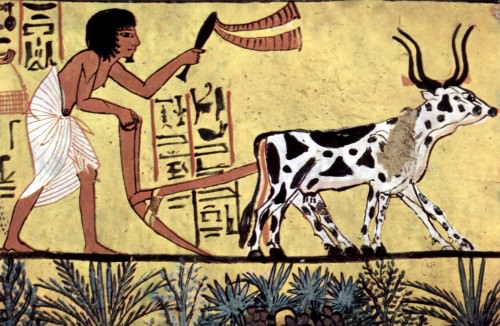
Plowing Egyptian Farmer
Papyrus was used for a number of products. Although it is most commonly recognized as the raw material for paper, papyrus was also used to make sandals, rope, material for dolls, boxes, baskets, mats, window shades, as a food source, and even to make small fishing boats. The castor oil plant was crushed and used for lamp oil and also as a tonic. Flax was used for rope and clothing and sometimes in the manufacture of footwear.
Among the most important crops was the emmer which went into the production of beer, the most popular drink in Egypt, and bread, a daily staple of the Egyptian diet. When Rome annexed Egypt after 30 BCE, wheat production gradually declined in favor of the cultivation of grapes because the Romans favored wine over beer. Prior to the coming of Rome, however, emmer was probably the most important crop regularly grown in Egypt after papyrus.
FARMERS & TRADE
The individual farmers would make their living from the crops in a number of ways. If one were a private landowner, of course, one could do as one wished with one's crops (keeping in mind that one would have to pay a certain amount to the state in taxes). Most farmers worked on land owned by the nobles or the priests or other wealthy members of society, and so the men would typically tend the fields and surrender the produce to the noble while keeping a small amount for personal use. The wives and children of these tenant farmers often kept small gardens they tended for the family, but agriculture was primarily a man's work. Egyptologist Joyce Tyldesley writes:
Women are not conventionally illustrated ploughing, sowing, or looking after the animals in the fileds, but they are shown providing refreshments for the labourers, while gleaning was an approved female outdoor activity recorded in several tomb scenes; women and children follow the official harvesters and pick up any ears of corn which have been left behind. Of equal, or perhaps greater, importance were the small-scale informal transactions conducted between women, with one wife, for example, simply agreeing to swap a jug of her homemade beer for her neighbour's excess fish. This type of exchange, which formed the basis of the Egyptian economy, allowed the careful housewife to convert her surplus directly into useable goods, just as her husband was able to exchange his labour for his daily bread. (137-138)
Such exchanges, in good years, often involved the family garden and produce served as currency in transactions. Fishing was a daily activity for many, if not most, of the lower classes as a means to supplement their income, and Egyptians were known as expert fishermen. Ancient Egypt was a cashless society up until the time of the Persian Invasion of 525 BCE, and so the more one had to barter with, the better one's situation.
AGRICULTURE & PERSONAL WEALTH
The monetary unit of ancient Egypt was the deben which, according to historian James C. Thompson, "functioned much as the dollar does in North America today to let customers know the price of things, except that there was no deben coin " (Egyptian Economy, 1). A deben was "approximately 90 grams of copper ; very expensive items could also be priced in debens of silveror gold with proportionate changes in value" (ibid). Thompson continues:
Since seventy-five litters of wheat cost one deben and a pair of sandals also cost one deben, it made perfect sense to the Egyptians that a pair of sandals could be purchased with a bag of wheat as easily as with a chunk of copper. Even if the sandal maker had more than enough wheat, she would happily accept it in payment because it could easily be exchanged for something else. The most common items used to make purchases were wheat, barley, and cooking or lamp oil, but in theory almost anything would do. (1)
This same system of barter which took place on the most modest scale throughout the villages of Egypt was also the paradigm in the cities and in international trade. Egypt shipped its produce to Mesopotamia, the Levant, India, Nubia, and the Land of Punt (modern-day Somalia) among others. Crops were harvested and stored at the local level and then a portion collected by the state and moved to the Royal Granaries in the capital as taxes.

Ancient Egyptian Weight of One Deben
Bunson notes how "assessors were sent from the capital to the provinces to collect taxes in the form of grain" and how the local temples "had storage units and were subject to taxes in most eras unless exempted for a particular reason or favor" (5).Temples to especially popular gods, such as Amun, grew wealthy from agriculture, and Egypt's history repeatedly turns on conflicts between the priests of Amun and the throne.
CONCLUSION
Following the annexation of Egypt by Rome, Egypt served as the "breadbasket" of the Roman Empire and was increasingly called upon to supply food for the empire 's ever-expanding reach. This situation would continue even after the fall of the Western Roman Empire in 476 CE as Egypt continued to be controlled by the Eastern (Byzantine) Roman Empire until it was taken in the Arab Invasion of the 7th century CE.
Between the time of the Arab Invasion and the fall of the Byzantine Empire in 1453 CE, Egypt continued its long tradition of agricultural pursuits which have been maintained since. Although the major commercial fields and farms of Egypt in the present day are worked using more advanced technology, the old patterns of agriculture can still be observed in small farms and villages.
LICENSE
Article based on information obtained from these sources:with permission from the Website Ancient History Encyclopedia
Content is available under License Creative Commons: Attribution-NonCommercial-ShareAlike 3.0 Unported. CC-BY-NC-SA License